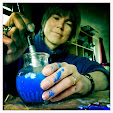 |
| Screenprint made in the studio - edition of 4. |
Black and white players are moving across the flat chequerboard of fields on Oronsay. They are pawns in a large-as-life game of biodiversity, played out on the land. The Barnacle Geese look out of place on these fields. The black and white markings which camouflage them against the rocky screes of their nesting cliffs in Greenland look incongruous here. They are seeking refuge from the frozen weather of the North and, alongside the black Hebridean Sheep, they are grazing the winter grass short.
It may be the RSPB who are controlling the game by offering rich, undisturbed grazing on the in-by fields, but on this island at least, it is the wildlife who are the winners. Once the geese have been cleared from the board by the southerly winds of spring, the star players will move in. The clues are to be seen around the winter field margins. The woody remains of knapweed, cow parsely, dock and nettle show how the game will develop. The vegetation will grow in the Spring sunshine to provide cover for Corncrakes as they return from sub-Saharan Africa to breed. These are the kings and queens of the island. With the field cleared by the winter workers, new growth will be open, allowing these shy rails to pass easily through it.
Corncrakes have disappeared from most of mainland Britain, and so management here concentrates on sustaining these birds, the vulnerable key pieces of the chess board. They may have reached check-mate elsewhere, but with 24 calling males in these few fields, the game is still on.
 |
| Sketch made in the field. |





